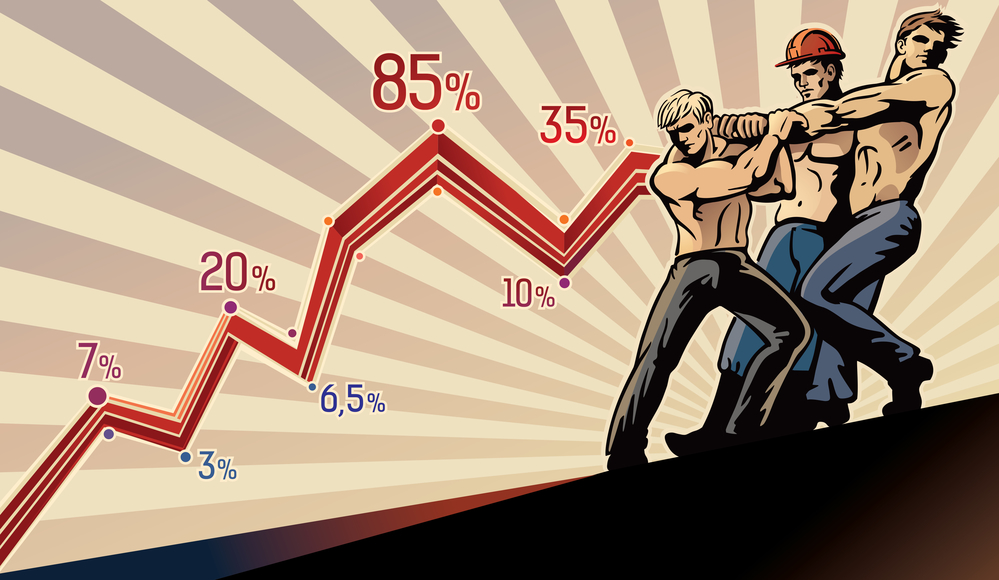Mike Pence told the crowd at CPAC (Conservative Political Action Conference) that ‘we will never be a socialist country.’
What was that? A prediction? Or just political BS?
Already, America’s medical system — 17% of the economy — is largely socialised. So is the education system — another 7.3%. And its national pension system…Social Security…is run by the feds and takes up about 5% of GDP.
If you add in all the industries and activities that are required by the feds, or heavily controlled by them…the total comes to about half the GDP. How much of an economy do you have to socialise before you have a socialist country?
We don’t know. And we don’t want to find out. But we suspect the answer has something to do with another bit of political puffery at the ‘conservative’ confab.
Spin statistics
Donald J Trump told CPAC attendees that the ‘economy is booming like never before.’ He was right; never in US history has the economy performed so badly.
Fantasies are always much more appealing than truth…Especially in politics. And you can spin statistics into almost any shape you want.
But let’s take a look. First, here is what most people believe…
That the economy is growing strongly…
Unemployment is at a record low (beyond full employment)…
Federal deficits don’t matter; the government can print all the money it wants…
And the Fed is masterfully twisting knobs and pulling levers to make sure that nothing ever goes wrong.
Except…it is all false.
[openx slug=inpost]
Urgent matter
In the first place, if the economy really were doing so well, why would the Fed ‘pause’ its rate hikes, instead of continuing its ‘normalisation’ program?
It knows full well that there are still ups and downs in an economy. As recently as 10 years ago, the stock market got cut in half and the economy was headed for depression.
The cause? Too much debt. And now, debt levels are even higher. The Fed knows the next downturn will need to be fought with lower interest rates. But you can’t cut interest rates if you don’t have any interest rates to cut.
This is getting to be an urgent matter. If it lasts until August, this recovery will be the longest ever recorded. Yes, it could go on forever. But it is a bad bet. The Fed is going to need some rates to cut…and soon.
In the last two downturns, the Fed lopped five percentage points off the federal funds rate, each time. Even that was barely enough; the last recovery — in which we are at the tail end — is the weakest ever.
GDP growth rates have been going down for 40 years. Smoothing them out by averaging them over a trailing 10-year period, we see the blazing-hot rates in the 1960s and 1970s…around 4% and 3.5%.
But now? Over the last decade, average yearly growth rates have cooled to just 1.5%.
Personal consumption rates give us a good idea of what is going on, too. People spend money when their real incomes are rising. In the 1970s, consumption spending rose about 12% per year.
Now, PCE (Personal Consumption Expenditures) growth averages only about 6%. (Unchanged from the Obama years.)
Hard to rig
Final sales are the other side of consumption. Those raw numbers are hard to rig. And they show the same thing. They’ve been in a downward trend since the 1970s.
Did the tax cut of late 2017 reverse that trend? Not at all.
From the year before the tax cut took effect, to a year later, final sales rose only 0.1% — that is, one-tenth of 1%…a statistically insignificant move.
National savings, same thing. Only worse. From the 10-12% range in the 1970s, the rate today stands at about 6.5%…again, little changed (and in the wrong direction) from the Obama misfortune.
The GDP growth rate for 2018 was virtually identical to the growth rate of 2015 — about 2.9%. And the first two years of the Trump Administration, averaged together, have seen almost the same GDP growth as the last two years of the Obama Team — about 2.5%.
And note that this was very expensive growth. The Trump Team adds $100 billion per month to the nation’s debt. This produces growth of only $40 billion a month.
Ball and chain
On the campaign trail, Donald J Trump had promised to pay off the national debt in eight years. No one believed him, not even the candidate himself.
By then, the national emergency that followed the crash of 2009 — making sure the elite didn’t lose money on their investments — was over.
The rich were back in high clover. But the Trump Team simply picked up where Obama had left off…and added another $2 trillion to the taxpayers’ ball and chain.
Together, Obama and Trump seem to have made the worst economic deal of all time.
In the 1930-1940 period, also known as The Great Depression, US government debt increased from $17 billion to $43 billion, a $26 billion increase.
But it produced $300 billion worth of real additional annual GDP. In the 2008-2019 period, real GDP increased by only $3 trillion at a cost of $13 trillion of extra debt.
In effect, they socialised capitalism.
The elite speculate. When there are losses, they are dumped onto the middle classes…as debt.
Regards,
Bill Bonner
